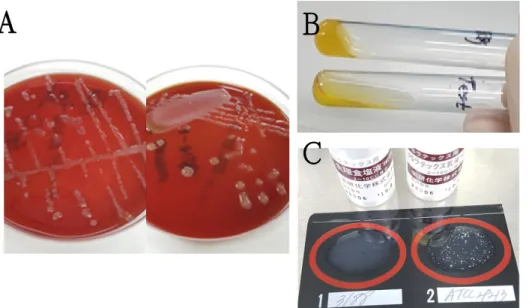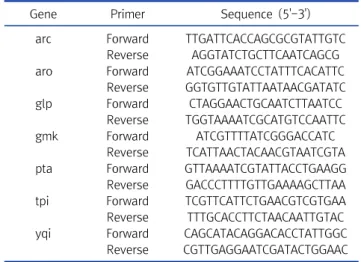* Corresponding author: Ga Yeon Kim
Department of Public Health, Dankook University Graduate School, Dandae-ro, Dongnam-gu, Cheonan 31116, Korea
E-mail: sysnhj77@gmail.com
* ORCID: https://orcid.org/0000-0001-8751-5055
CASE REPORT
Non-hemolytic, Mucinous, Coagulase Negative MRSA Isolated from Urine
Jae Soo Kim1, Qute Choi2, Bo Kyeung Jung3, Jong Wan Kim3, Ga Yeon Kim4
1Department of Laboratory Medicine, Dankook University Hospital, Cheonan, Korea
2Department of Laboratory Medicine, Chungnam National University College of Medicine, Daejeon, Korea
3Department of Laboratory Medicine, Dankook University College of Medicine, Cheonan, Korea
4Department of Public Health, Dankook University Graduate School, Cheonan, Korea
소변에서 분리된 비용혈성, 점액성, 응고효소 음성 MRSA
김재수1, 최규태2, 정보경3, 김종완3, 김가연4
1단국대학교병원 진단검사의학과, 2충남대학교 의과대학 진단검사의학과, 3단국대학교 의과대학 진단검사의학과, 4단국대학교 대학원 보건학과
ARTICLE INFO ABSTRACT
Received March 30, 2019 Revised 1st May 15, 2019 Revised 2nd May 30, 2019 Revised 3rd May 31, 2019 Accepted June 1, 2019
An 84-year-old woman presented to the emergency department with a chief complaint of pressure sores of the anus. She had a urine catheter when she showed pyuria three times but had no fever.
A microscopic examination revealed many grapevine-like Gram positive strains and neutrophils.
After 24 hours of urine culture on blood agar, non-hemolytic mucous colonies were found and further enlarged after 48 hours of culture. The capsules were identified after India ink stain. The catalase was positive, but the tube coagulase and latex coagulase were both negative. The S. aureus was identified by Vitek-2 and mass spectrometer Vitek MS V-3 IVD. The strain was confirmed by 16S rRNA gene sequencing and multilocus sequence typing (MLST). The phenotypically atypical MRSA found in the tube coagulase and latex coagulase were both negative.
MRSA often show no beta hemolysis as in this case but are rarely latex coagulase-negative. We report a woman whose urine culture showed non-hemolytic, tube coagulase-negative, and latex coagulase-negative MRSA.
Copyright © 2019 The Korean Society for Clinical Laboratory Science. All rights reserved.
Key words
Coagulase-negative MRSA Latex coagulase-negative MRSA Non-hemolytic MRSA
INTRODUCTION
Staphylococcus aureus (S. aureus) is classified into facultative anaerobic Gram-positive cocci which do not form spore. S. aureus is positive both for catalase and coagulase test. Coagulase-negative staphylococcus (CNS) is generally considered to be less pathogenic than S. aureus [1]. Meanwhile, the increased prevalence of methicillin
resistant S. aureus (MRSA) resulting in increased antimicrobial resistance is difficult to treat [2, 3]. The S.
aureus is the causative agent of many diseases such as skin infection, pneumonia, endocarditis and osteomyelitis.
Some strains produce toxins that cause gastroenteritis, skin elasticity syndrome and toxic shock syndrome. It also causes food poisoning and is one of the most frequently isolated bacterias in patients [1]. The diagnosis is mostly based on Gram stain and culture [3, 4]. The methicillin resistance of S. aureus is caused by mecA gene which is transcripted to transformed penicillin binding protein (PBP 2a). Vancomycin is an acceptable treatment option
Korean Society for Clinical Laboratory Science
A B
C
Figure 1. Non-hemolytic, mucinous, coagulase negative MRSA isolated from urine. (A) Non-hemolytic, mu- cinous MRSA colony. (B) Tube coa- gulase negative and (C) Latex coa- gulase negative MRSA.
Figure 2. The capsules of S. aureus were observed by india ink stain (×1000).
for MRSA and the recent emergence of clinical isolates resistant to vancomycin has made control of S. aureus be difficult [5]. Newer agents such as linezolid, daptomycin, telavancin, and ceftaroline have received regulatory approval for MRSA control [6].
Here, we report the MRSA strain isolated from the urine which show unique characteristics [7-9]. The isolate was non-hemolytic, tube coagulase negative and latex coagulase negative MRSA strain.
CASE REPORT
The patient visited the emergency department on March 3, 2017. She was an 84-year-old woman with pressure sores of the anus. She was transferred from nursing hospital nearby and had dementia and the history of back surgery. She was with urine catheter when admitted and showed pyuria three times but had no fever.
The urinalysis was performed; protein 2+, occult blood 3+, WBC 3+ and RBC: 10∼29/High Power Field (HPF), and WBC: >100/HPF on microscopic examination. The Gram stain was performed and a large number of Gram-positive cocci clusters and >25 WBCs (×1,000 magnification) on microscope were observed. The culture on blood agar and MacConkey agar was done following standard method using 0.001 mL disposable loops and incubated at 36°C in 5% CO2 for 24∼48 hours. In the blood
agar medium, a strong mucinous colony with diameter of 2∼3 mm was observed above 105 CFU/mL. The mucus was further enlarged after 48 hours of incubation. We assessed the number of bacteria per 1 mL of urine. The catalase was positive but the tube coagulase and the latex coagulase were both negative (Figure 1). The capsules were confirmed by India ink stain (Figure 2). The bacterial identification and antibiotics susceptibility testing were performed using Vitek-2 (Biomerieux Clinical Diagnostic, France). The colony showed antibiotic resistance to penicillin (≥0.5) and oxacillin (≥4) and susceptibility to gentamicin (≤0.5) and vancomycin (≤0.5). The MRSA was identified by Vitek-2 and mass spectrometer Vitek MS V-3 IVD (Biomerieux Clinical Diagnostic, France). The 16S rRNA gene sequencing (Table 1, Figure 3) and Multilocus Sequence Typing (MLST) revealed S. aureus which is 99.9%
Figure 3. Bacterial identification using 16S rRNA sequencing. (A) Dia- grammatic representation of 16S gene and relative primer positions. In addition to highly conserved primer binding sites, 16S rRNA gene se- quences contain hypervariable regions that can provide species-specific sig- nature sequences useful for iden- tification of bacteria. (B) Part of se- quencing electropherogram.
Table 1. Primers used for 16S rRNA Sequencing
Primer name Sequence (5'-3')
27F AGAGTTTGATCMTGGCTCAG
533F GTGCCAGCMGCCGCGGTAA
907R CCGTCAATTCCTTTRAGTTT
1492R CGGTTACCTTGTTACGACTT
Table 2. Primers for Multilocus Sequence Typing (MLST)
Gene Primer Sequence (5'-3')
arc Forward TTGATTCACCAGCGCGTATTGTC
Reverse AGGTATCTGCTTCAATCAGCG
aro Forward ATCGGAAATCCTATTTCACATTC
Reverse GGTGTTGTATTAATAACGATATC
glp Forward CTAGGAACTGCAATCTTAATCC
Reverse TGGTAAAATCGCATGTCCAATTC
gmk Forward ATCGTTTTATCGGGACCATC
Reverse TCATTAACTACAACGTAATCGTA
pta Forward GTTAAAATCGTATTACCTGAAGG
Reverse GACCCTTTTGTTGAAAAGCTTAA
tpi Forward TCGTTCATTCTGAACGTCGTGAA
Reverse TTTGCACCTTCTAACAATTGTAC
yqi Forward CAGCATACAGGACACCTATTGGC
Reverse CGTTGAGGAATCGATACTGGAAC
agreement with the standard strain ATCC 29213 (Table 2, Figure 4). The patient was treated with vancomycin 15-20 mg/kg IV every 8∼12 hr and was discharged after culture-negative.
DISCUSSION
Many of the genes coding for extracellular toxins, enzymes, and cell surface proteins of S. aureus are regulated by a 510-nucleotide (nt) RNA molecule, RNAIII.
These are controlled by a complex regulatory locus, an gene regulator (agr) [10-12], whose unique feature is control of the expression of its target genes by means of an RNA molecule (RNAIII) [13]. agr RNAIII acts as a positive regulator on genes which are preferentially expressed postexponentially, whereas protein A and coagulase are inhibited. The kinetics of protein A gene (spa) tran- scription has been investigated with agr and agr mutant strains [14] and shown to be inversely related to the level
of RNAIII. RNAIII had a strict inhibitory effect on spa expression. The regulation of coa expression is different from that of spa, in that coagulase expression may be modulated both positively and negatively by the agr system according to the growth stage. Therefore, coagulase expression appears to be both positively and negatively modulated by an agr-dependent mechanism [15], and the agr-dependent repression effect on coa mRNA is most probably the result of a direct binding of RNAIII to coa mRNA [16].
We found phenotypically atypical MRSA in that tube coagulase and latex coagulase were both negative. The
Figure 4. Multilocus sequence typing [MLST] analysis using PubMLST site (https://pubmlst.org/).
MRSA often show no beta-hemolysis like our case patient but rarely latex coagulase-negative. We emphasize the role of 16S rRNA gene sequencing and MLST to fully ensure correct species diagnosis especially when it shows ambiguous biochemical findings [17]. Here, we report a case of an 84-year-old woman whose urine culture showed non-hemolytic, tube coagulase-negative and latex coagulase-negative MRSA.
요 약
84세 여성이 항문까지 욕창이 번져 응급실에 내원하였다. 그 녀는 근처의 요양기관에서 전원되었고, 입원시 소변 도뇨관을 달고 있었으며 열은 없었다. 그람염색에서 많은 수의 포도상구 균과 >25의 호중구 (×1000배 렌즈)가 관찰되었다. 24시간 배 양한 혈액한천배지에서 용혈이 없는 점액성의 집락이 관찰되었 으며 배양 48시간에는 점액성이 더욱 확대되었다. India ink로 염색하여 협막의 모습을 관찰하였으며, 카타라제 양성, 라텍스 법 혈액응고효소 음성, 시험관법 혈액응고효소 음성소견을 보 였다. Vitek-2와 질량분석기인 Vitek MS V-3 IVD에서 S.
aureus로 나타났으며, 16S rRNA 유전자 염기서열 분석 및 Multilocus sequencing typing (MLST)에서 S. aureus로 표준 균주인 ATCC 29213과 99.9% 일치를 보였다.
본 증례는 용혈성이 없고, 점액성이 강하며, 라텍스법 혈액응 고효소 음성, 시험관법 혈액응고효소 음성소견을 보이는 MRSA 를 동정하여 이를 보고한다.
Acknowledgements: None Conflict of interest: None
Author’s information (Position): Kim JS1, M.T.; Choi Q2, M.D.; Jung BK3, M.D.; Kim JW3, M.D.; Kim GY4, Professor.
REFERENCES
1. Svec P, Vancanneyt M, Sedlácek I, Engelbeen K, Stetina V, Swings J, et al. Reclassification of Staphylococcus pulvereri Zakrzewska- Czerwinska et al. 1995 as a later synonym of Staphy- lococcus vitulinus Webster et al. 1994. Int J Syst Evol Microbiol.
2004;54:2213–2215. https://doi.org/10.1099/ijs.0.63080-0.
2. Kim KM, Yoo JH, Choi JH, Park ES, Kim SR, Kim SM, et al. The national surveillance results of nosocomial infections along with antimicrobial resistance in intensive care units of sixteen university hospitals in Korea, 2004. Korean J Nosocomial Infect Control. 2006;11:79-86.
3. Araki M, Kariyama R, Monden K, Tsugawa M, Kumon H.
Molecular epidemiological studies of Staphylococcus aureus in urinary tract infection. J Infect Chemother 2002;8:168-174.
https://doi.org/10.1007/s101560200029.
4. Jones JW, Carter A, Ewings P, O’Boyle PJ. An MRSA outbreak in a urology ward and its association with Nd:YAG coagulation la- ser treatment of the prostate. J Hosp Infect 1999;41:39-44.
https://doi.org/10.1016/S0195-6701(99)90035-X.
5. Moran GJ, Mount J. Staphylococcus aureus resistant to vanco- mycin—United States, 2002. Ann Emerg Med. 2003;41:148-151.
6. Choo EJ. Antimicrobial therapy for methicillin-resistant Staphy- lococcus aureus. J Korean Med Assoc. 2018;61:207-213.
https://doi.org/10.5124/jkma.2018.61.3.207.
7. Gilbert, I. Dissociation in an encapsulated staphylococcus. J Bacteriol. 1931;21:157-160.
8. Yoshida K. Demonstration of serologically different capsular types among strains of Staphylococcus aureus by the se- rum-soft agar technique. Infect Immun. 1971;3:535-539.
9. Yoshida K, Smith MR, Naito Y. Biological and immunological properties of encapsulated strains of Staphylococcus aureus from human sources. Infect Immun. 1970;2:528-532.
10. Morfeldt E, Janzon L, Arvidson S, Lofdahl S. Cloning of a chro- mosomal locus (exp) which regulates the expression of several
exoprotein genes in Staphylococcus aureus. Mol Gen Genet.
1988;211:435-440.
11. Peng HL, Novick RP, Kreiswirth B, Kornblum J, Schlievert P.
Cloning, characterization, and sequencing of an accessory gene regulator (agr) in Staphylococcus aureus. J Bacteriol. 1988;170:
4365-4372.
12. Recsei P, Kreiswirth B, Reilly MO, Schlievert P, Gruss A, Novick RP. Regulation of exoprotein gene expression in Staphylo- coccus aureus by agr. Mol. Gen. Genet. 1986;202:58-61.
13. Novick RP, Ross HF, Projan SJ, Kornblum J, Kreiswirth B, Moghazeh S. Synthesis of staphylococcal virulence factors is controlled by a regulatory RNA molecule. EMBO J. 1993;12:
3967-3975.
14. Vandenesch F, Kornblum J, Novick RP. A temporal signal, in- dependent of agr, is required for hla but not spa transcription in
Staphylococcus aureus. J Bacteriol. 1991;173:6313-6320.
15. Lebeau C, Vandenesch F, Greenland T, Novick RP, Etienne J.
Coagulase expression in Staphylococcus aureus is positively and negatively modulated by an agr-dependent mechanism. J Bacteriol. 1994;17:5534-5536.
16. Chevalier C, Boisset S, Romilly C, Masquida B, Fechter P, et al.
Staphylococcus aureus RNAIII binds to two distant regions of coa mRNA to arrest translation and promote mRNA de- gradation. PLoS Pathog. 2010;6:E1000809. https://do- i.org/10.1371/journal.ppat.1000809.
17. Akineden Ö, Hassan AA, Schneider E, Usleber E. A coagu- lase-negative variant of Staphylococcus aureus from bovine mastitis milk. J Dairy Res. 2011;78:38-42. https://doi.org/
10.1017/S0022029910000774.


![Figure 4. Multilocus sequence typing [MLST] analysis using PubMLST site (https://pubmlst.org/).](https://thumb-ap.123doks.com/thumbv2/123dokinfo/5450259.238077/4.892.129.765.146.354/figure-multilocus-sequence-typing-mlst-analysis-pubmlst-pubmlst.webp)